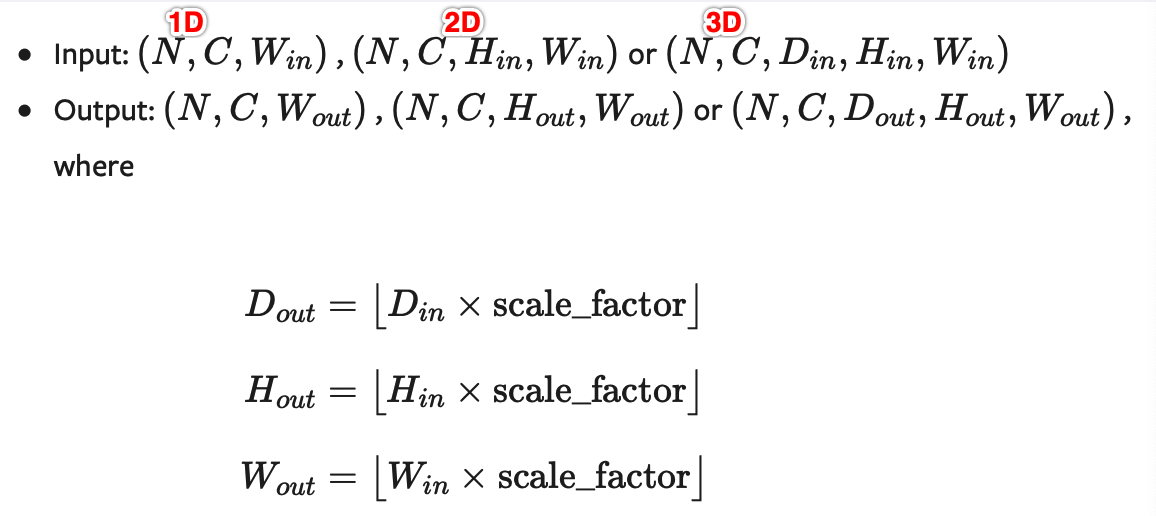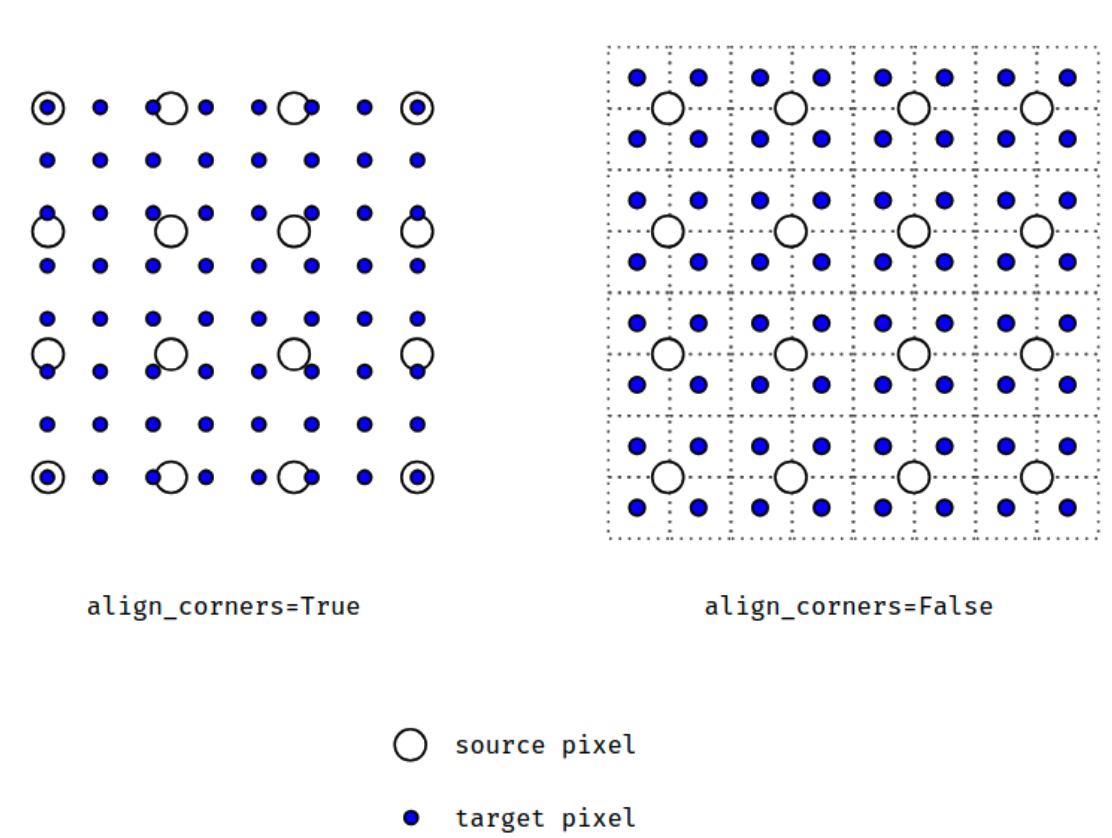pytorch torch.nn.functional实现插值和上采样
interpolate
torch.nn.functional.interpolate(input, size=None, scale_factor=None, mode='nearest', align_corners=None)
根据给定的size或scale_factor参数来对输入进行下/上采样
使用的插值算法取决于参数mode的设置
支持目前的temporal(1D, 如向量数据), spatial(2D, 如jpg、png等图像数据)和volumetric(3D, 如点云数据)类型的采样数据作为输入,输入数据的格式为minibatch x channels x [optional depth] x [optional height] x width,具体为:
- 对于一个temporal输入,期待着3D张量的输入,即minibatch x channels x width
- 对于一个空间spatial输入,期待着4D张量的输入,即minibatch x channels x height x width
- 对于体积volumetric输入,则期待着5D张量的输入,即minibatch x channels x depth x height x width
可用于重置大小的mode有:最近邻、线性(3D-only),、双线性, 双三次(bicubic,4D-only)和三线性(trilinear,5D-only)插值算法和area算法
参数:
input (Tensor) – 输入张量
size (int or Tuple[int] or Tuple[int, int] or Tuple[int, int, int]) –输出大小.
scale_factor (float or Tuple[float]) – 指定输出为输入的多少倍数。如果输入为tuple,其也要制定为tuple类型
mode (str) –
可使用的上采样算法,有'nearest','linear','bilinear','bicubic','trilinear'和'area'.默认使用'nearest'align_corners (bool, optional) –
几何上,我们认为输入和输出的像素是正方形,而不是点。如果设置为True,则输入和输出张量由其角像素的中心点对齐,从而保留角像素处的值。如果设置为False,则输入和输出张量由它们的角像素的角点对齐,插值使用边界外值的边值填充;当scale_factor保持不变时,使该操作独立于输入大小。仅当使用的算法为'linear','bilinear', 'bilinear'or'trilinear'时可以使用。默认设置为False

注意:
使用mode='bicubic'时,可能会导致overshoot问题,即它可以为图像生成负值或大于255的值。如果你想在显示图像时减少overshoot问题,可以显式地调用result.clamp(min=0,max=255)。
When using the CUDA backend, this operation may induce nondeterministic behaviour in be backward that is not easily switched off. Please see the notes on Reproducibility for background.
警告:
当align_corners = True时,线性插值模式(线性、双线性、双三线性和三线性)不按比例对齐输出和输入像素,因此输出值可以依赖于输入的大小。这是0.3.1版本之前这些模式的默认行为。从那时起,默认行为是align_corners = False,如下图:

上面的图是source pixel为4*4上采样为target pixel为8*8的两种情况,这就是对齐和不对齐的差别,会对齐左上角元素,即设置为align_corners = True时输入的左上角元素是一定等于输出的左上角元素。但是有时align_corners = False时左上角元素也会相等,官网上给的例子就不太能说明两者的不同(也没有试出不同的例子,大家理解这个概念就行了)
举例:
import torch
from torch import nn
import torch.nn.functional as F
input = torch.arange(, , dtype=torch.float32).view(, , , )
input
返回:
tensor([[[[., .],
[., .]]]])
x = F.interpolate(input, scale_factor=, mode='nearest')
x
返回:
tensor([[[[., ., ., .],
[., ., ., .],
[., ., ., .],
[., ., ., .]]]])
x = F.interpolate(input, scale_factor=, mode='bilinear', align_corners=True)
x
返回:
tensor([[[[1.0000, 1.3333, 1.6667, 2.0000],
[1.6667, 2.0000, 2.3333, 2.6667],
[2.3333, 2.6667, 3.0000, 3.3333],
[3.0000, 3.3333, 3.6667, 4.0000]]]])
也提供了一些Upsample的方法:
upsample
torch.nn.functional.upsample(input, size=None, scale_factor=None, mode='nearest', align_corners=None)
torch.nn.functional.upsample_nearest(input, size=None, scale_factor=None)
torch.nn.functional.upsample_bilinear(input, size=None, scale_factor=None)
因为这些现在都建议使用上面的interpolate方法实现,所以就不解释了
更加复杂的例子可见:pytorch 不使用转置卷积来实现上采样
pytorch torch.nn.functional实现插值和上采样的更多相关文章
- PyTorch : torch.nn.xxx 和 torch.nn.functional.xxx
PyTorch : torch.nn.xxx 和 torch.nn.functional.xxx 在写 PyTorch 代码时,我们会发现一些功能重复的操作,比如卷积.激活.池化等操作.这些操作分别可 ...
- [pytorch笔记] torch.nn vs torch.nn.functional; model.eval() vs torch.no_grad(); nn.Sequential() vs nn.moduleList
1. torch.nn与torch.nn.functional之间的区别和联系 https://blog.csdn.net/GZHermit/article/details/78730856 nn和n ...
- Pytorch本人疑问(1) torch.nn和torch.nn.functional之间的区别
在写代码时发现我们在定义Model时,有两种定义方法: torch.nn.Conv2d()和torch.nn.functional.conv2d() 那么这两种方法到底有什么区别呢,我们通过下述代码看 ...
- torch.nn.functional中softmax的作用及其参数说明
参考:https://pytorch-cn.readthedocs.io/zh/latest/package_references/functional/#_1 class torch.nn.Soft ...
- 从 relu 的多种实现来看 torch.nn 与 torch.nn.functional 的区别与联系
从 relu 的多种实现来看 torch.nn 与 torch.nn.functional 的区别与联系 relu多种实现之间的关系 relu 函数在 pytorch 中总共有 3 次出现: torc ...
- pytorch torch.nn 实现上采样——nn.Upsample
Vision layers 1)Upsample CLASS torch.nn.Upsample(size=None, scale_factor=None, mode='nearest', align ...
- Pytorch——torch.nn.Sequential()详解
参考:官方文档 源码 官方文档 nn.Sequential A sequential container. Modules will be added to it in the order th ...
- PyTorch官方中文文档:torch.nn
torch.nn Parameters class torch.nn.Parameter() 艾伯特(http://www.aibbt.com/)国内第一家人工智能门户,微信公众号:aibbtcom ...
- 『PyTorch』第十二弹_nn.Module和nn.functional
大部分nn中的层class都有nn.function对应,其区别是: nn.Module实现的layer是由class Layer(nn.Module)定义的特殊类,会自动提取可学习参数nn.Para ...
随机推荐
- 请解释下在单线程模型中Message、Handler、MessageQueue、Looper之间的关系
对于面试,每个职场人士都经历过,面试官更看中你对于技术的理解是否透彻,需要知其所以然,而实际工作中看中的工作效率,都是在使用API的角度来完成任务,当在一家公司呆久了有跳槽的想法时,个人的亲身经历就是 ...
- vbs剪切Excel某一行
set oExcel = CreateObject( "Excel.Application" ) '创建oExcel对象 oExcel.Visible = false '4) 打开 ...
- 再论strlen sizeof
今天,在使用字符串的时候,对sizeof和strlen的用法更加深入了,特此记录下. strlen是运行是计算的,不能放在函数外面计算的sizeof是预编译时运行的,可以放在函数外面计算. 对于cha ...
- Dubbo源码分析:Dubbo协议解码
Dubbo协议解码时序图
- Vue基础入门笔记
不是面向DOM进行编程,而是面向数据去编程.当数据发生改变,页面就会随着改变. 属性绑定(v-bind)和双向数据绑定(v-model) 模板指令(v-bind:)后面跟的内容不再是字符串而是: js ...
- cube.js 学习(七)cube.js type 以及format 说明
cube.js 对于measure以及dimension 提供了丰富的数据类型,基本满足我们常见应用的开发,同时对于不同类型也提供了 格式化的操作 measure类型 number 格式 purc ...
- while循环实现十进制转二进制
#include <stdio.h> int main(void){ int a,n; printf("pls input number:\n"); scanf(&qu ...
- 在Matlab中的plot
在Matlab中画图时,经常会使用plot函数命令.一些隐含的画图命令也默认调用plot函数命令,如spy命令,可以画出矩阵的稀疏度图形. 另外,有时为了方便,会将一些处理图形的操作和命令列在一块,命 ...
- RS译码的描述
在描述Reed-Solomon码的译码时,需要确定错误多项式的系数,然后进行搜索.通常,错误多项式的最高次数与错误的符号数相同. 如: λ(X)= λ0+ λ1X+ ...+ λνXν. 设该RS码最 ...
- Resolving EACCES permissions errors when installing packages globally(npm 遇到 write access的问题)
If you see an EACCES error when you try to install a package globally, you can either: Reinstall npm ...
